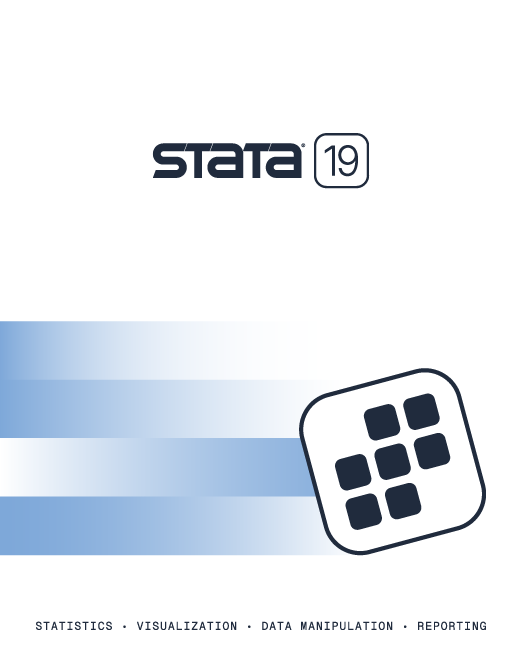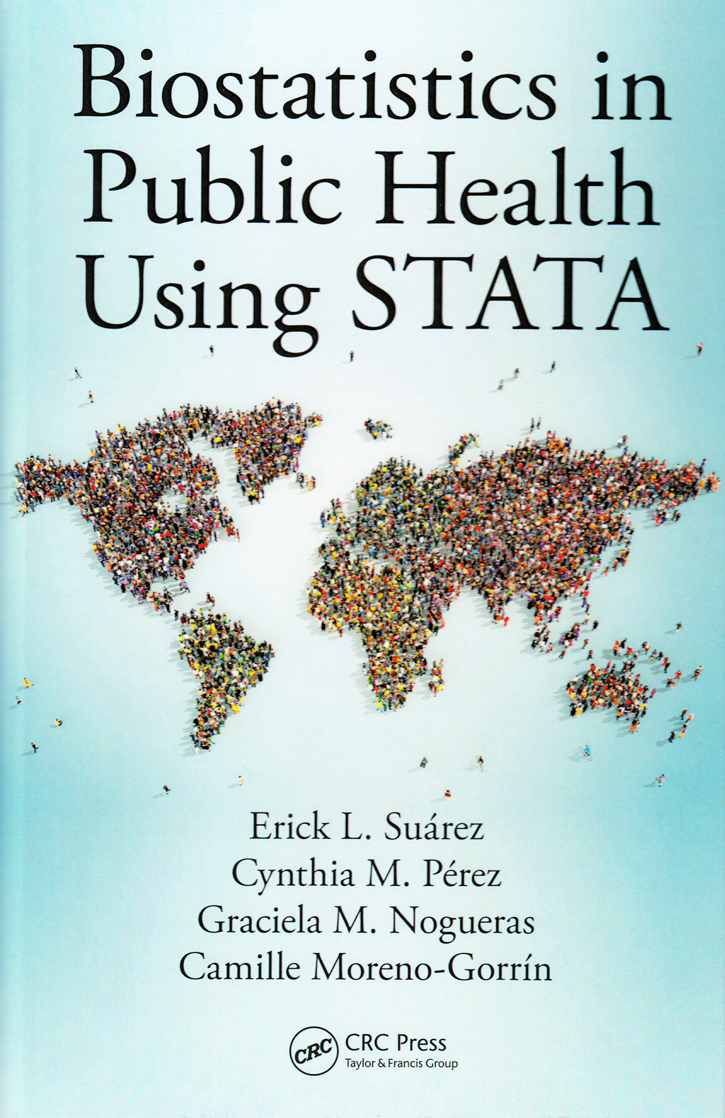

2025 Stata Conference • Nashville, TN • 31 July–01 August
Biostatistics in Public Health Using Stata |
||||||||||||||||||||||||||||||||||||
 Click to enlarge See the back cover |

As an Amazon Associate, StataCorp earns a small referral credit from
qualifying purchases made from affiliate links on our site.
eBook not available for this title
eBook not available for this title |
|
||||||||||||||||||||||||||||||||||
Comment from the Stata technical groupThis book demonstrates the use of Stata for statistical analyses common in public health research and in many other disciplines. For those new to Stata, the authors first provide an introduction to Stata's interface and to commands for descriptive statistics and graphics. In the discussions of statistical procedures that follow, readers will find extensive coverage of Stata's menus, dialog boxes, commands, and output. Topics include linear regression, analysis of variance, logistic regression, Poisson regression, survival analysis, multilevel mixed-effects models, and power and sample-size analysis. |
||||||||||||||||||||||||||||||||||||
Table of contentsView table of contents >> Preface
Acknowledgments
Authors
1 Basic Commands
1.1 Introduction
1.2 Entering Stata 1.3 Taskbar 1.4 Help 1.5 Stata Working Directories 1.6 Reading a Data File 1.7 insheet Procedure 1.8 Types of Files 1.9 Data Editor 2 Data Description
2.1 Most Useful Commands
2.2 list Command 2.3 Mathematical and Logical Operators 2.4 generate Command 2.5 recode Command 2.6 drop Command 2.7 replace Command 2.8 label Command 2.9 summarize Command 2.10 do-file Editor 2.11 Descriptive Statistics and Graphs 2.12 tabulate Command 3 Graph Construction
3.1 Introduction
3.2 Box Plot 3.3 Histogram 3.4 Bar Chart 4 Significance Tests
4.1 Introduction
4.2 Normality Test 4.3 Variance Homogeneity 4.4 Student's t-Test for Independent Samples 4.5 Confidence Intervals for Testing the Null Hypothesis 4.6 Nonparametric Tests for Unpaired Groups 4.7 Sample Size and Statistical Power 5 Linear Regression Models
5.1 Introduction
5.2 Model Assumptions 5.3 Parameter Estimation 5.4 Hypothesis Testing 5.5 Coefficient of Determination 5.6 Pearson Correlation Coefficient 5.7 Scatter Plot 5.8 Running the Model 5.9 Centering 5.10 Bootstrapping 5.11 Multiple Linear Regression Model 5.12 Partial Hypothesis 5.13 Prediction 5.14 Polynomial Linear Regression Model 5.15 Sample Size and Statistical Power 5.16 Considerations for the Assumptions of the Linear Regression Model 6 Analysis of Variance
6.1 Introduction
6.2 Data Structure 6.3 Example for Fixed Effects 6.4 Linear Model with Fixed Effects 6.5 Analysis of Variance with Fixed Effects 6.6 Programming for ANOVA 6.7 Planned Comparisons (before Observing the Data)
6.7.1 Comparison of Two Expected Values
6.8 Multiple Comparisons: Unplanned Comparisons 6.7.2 Linear Contrast 6.9 Random Effects 6.10 Other Measures Related to the Random Effects Model
6.10.1 Covariance
6.11 Example of a Random Effects Model 6.10.2 Variance and Its Components 6.10.3 Intraclass Correlation Coefficient 6.12 Sample Size and Statistical Power 7 Categorical Data Analysis
7.1 Introduction
7.2 Cohort Study 7.3 Case-Control Study 7.4 Sample Size and Statistical Power 8 Logistic Regression Model
8.1 Model Definition
8.2 Parameter Estimation 8.3 Programming the Logistic Regression Model
8.3.1 Using glm
8.4 Alternative Database 8.3.2 Using logit 8.3.3 Using logistic 8.3.4 Using binreg 8.5 Estimating the Odds Ratio 8.6 Significance Tests
8.6.1 Liklihood Ratio Test
8.7 Extension of the Logistic Regression Model 8.6.2 Wald Test 8.8 Adjusted OR and the Confounding Effect 8.9 Effect Modification 8.10 Prevalence Ratio 8.11 Nominal and Ordinal Outcomes 8.12 Overdispersion 8.13 Sample Size and Statistical Power 9 Poisson Regression Model
9.1 Model Definition
9.2 Relative Risk 9.3 Parameter Estimation 9.4 Example 9.5 Programming the Poisson Regression Model 9.6 Assessing Interaction Terms 9.7 Overdispersion 10 Survival Analysis
10.1 Introduction
10.2 Probability of Survival 10.3 Components of the Study Design 10.4 Kaplan–Meier Method 10.5 Programming of S(t) 10.6 Hazard Function 10.7 Relationship between S(t) and h(t) 10.8 Cumulative Hazard Function 10.9 Median Survival Time and Percentiles 10.10 Comparison of Survival Curves 10.11 Proportional Hazards Assumption 10.12 Significance Assessment
10.12.1 Log-Rank Test
10.13 Cox Proportional Hazards Model 10.12.2 Wilcoxon–Gehan–Breslow Test 10.12.3 Tarone–Ware Test 10.14 Assessment of the Proportional Hazards Assumption 10.15 Survival Function Estimation Using the Cox Proportional Hazards Model 10.16 Stratified Cox Proportional Hazards Model 11 Analysis of Correlated Data
11.1 Regression Models with Correlated Data
11.2 Mixed Models 11.3 Random Intercept 11.4 Using the mixed and gllamm Commands with a Random Intercept 11.5 Using the mixed Command with Random Intercept and Slope 11.6 Mixed Models in a Sampling Design 12 Introduction to Advanced Programming in Stata
12.1 Introduction
12.2 do-files 12.3 program Command 12.4 Log Files 12.5 trace Command 12.6 Delimiters 12.7 Indexing 12.8 Local Macros 12.9 Scalars 12.10 Loops (foreach and forvalues) 12.11 Application of matrix and local Commands for Prevalence Estimation References
Index |
||||||||||||||||||||||||||||||||||||
Learn
Free webinars
NetCourses
Classroom and web training
Organizational training
Video tutorials
Third-party courses
Web resources
Teaching with Stata
© Copyright 1996–2025 StataCorp LLC. All rights reserved.
×
We use cookies to ensure that we give you the best experience on our website—to enhance site navigation, to analyze usage, and to assist in our marketing efforts. By continuing to use our site, you consent to the storing of cookies on your device and agree to delivery of content, including web fonts and JavaScript, from third party web services.
Cookie Settings
Last updated: 16 November 2022
StataCorp LLC (StataCorp) strives to provide our users with exceptional products and services. To do so, we must collect personal information from you. This information is necessary to conduct business with our existing and potential customers. We collect and use this information only where we may legally do so. This policy explains what personal information we collect, how we use it, and what rights you have to that information.
These cookies are essential for our website to function and do not store any personally identifiable information. These cookies cannot be disabled.
This website uses cookies to provide you with a better user experience. A cookie is a small piece of data our website stores on a site visitor's hard drive and accesses each time you visit so we can improve your access to our site, better understand how you use our site, and serve you content that may be of interest to you. For instance, we store a cookie when you log in to our shopping cart so that we can maintain your shopping cart should you not complete checkout. These cookies do not directly store your personal information, but they do support the ability to uniquely identify your internet browser and device.
Please note: Clearing your browser cookies at any time will undo preferences saved here. The option selected here will apply only to the device you are currently using.